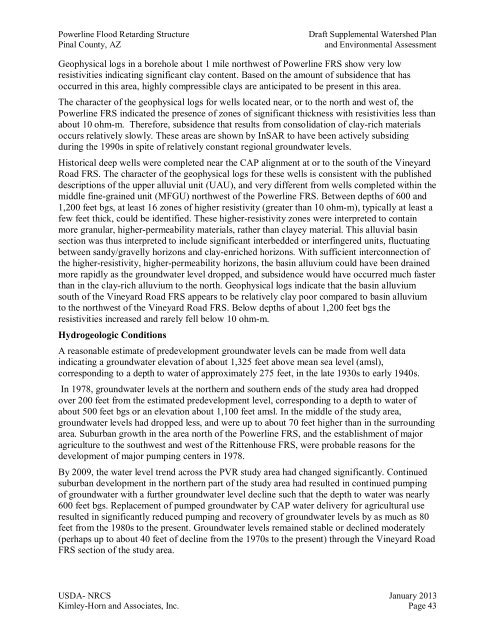Powerline Plan and Environ. Assessment Jan. 2013 - Flood Control ...
Powerline Plan and Environ. Assessment Jan. 2013 - Flood Control ...
Powerline Plan and Environ. Assessment Jan. 2013 - Flood Control ...
Create successful ePaper yourself
Turn your PDF publications into a flip-book with our unique Google optimized e-Paper software.
<strong>Powerline</strong> <strong>Flood</strong> Retarding Structure<br />
Pinal County, AZ<br />
Draft Supplemental Watershed <strong>Plan</strong><br />
<strong>and</strong> <strong>Environ</strong>mental <strong>Assessment</strong><br />
Geophysical logs in a borehole about 1 mile northwest of <strong>Powerline</strong> FRS show very low<br />
resistivities indicating significant clay content. Based on the amount of subsidence that has<br />
occurred in this area, highly compressible clays are anticipated to be present in this area.<br />
The character of the geophysical logs for wells located near, or to the north <strong>and</strong> west of, the<br />
<strong>Powerline</strong> FRS indicated the presence of zones of significant thickness with resistivities less than<br />
about 10 ohm-m. Therefore, subsidence that results from consolidation of clay-rich materials<br />
occurs relatively slowly. These areas are shown by InSAR to have been actively subsiding<br />
during the 1990s in spite of relatively constant regional groundwater levels.<br />
Historical deep wells were completed near the CAP alignment at or to the south of the Vineyard<br />
Road FRS. The character of the geophysical logs for these wells is consistent with the published<br />
descriptions of the upper alluvial unit (UAU), <strong>and</strong> very different from wells completed within the<br />
middle fine-grained unit (MFGU) northwest of the <strong>Powerline</strong> FRS. Between depths of 600 <strong>and</strong><br />
1,200 feet bgs, at least 16 zones of higher resistivity (greater than 10 ohm-m), typically at least a<br />
few feet thick, could be identified. These higher-resistivity zones were interpreted to contain<br />
more granular, higher-permeability materials, rather than clayey material. This alluvial basin<br />
section was thus interpreted to include significant interbedded or interfingered units, fluctuating<br />
between s<strong>and</strong>y/gravelly horizons <strong>and</strong> clay-enriched horizons. With sufficient interconnection of<br />
the higher-resistivity, higher-permeability horizons, the basin alluvium could have been drained<br />
more rapidly as the groundwater level dropped, <strong>and</strong> subsidence would have occurred much faster<br />
than in the clay-rich alluvium to the north. Geophysical logs indicate that the basin alluvium<br />
south of the Vineyard Road FRS appears to be relatively clay poor compared to basin alluvium<br />
to the northwest of the Vineyard Road FRS. Below depths of about 1,200 feet bgs the<br />
resistivities increased <strong>and</strong> rarely fell below 10 ohm-m.<br />
Hydrogeologic Conditions<br />
A reasonable estimate of predevelopment groundwater levels can be made from well data<br />
indicating a groundwater elevation of about 1,325 feet above mean sea level (amsl),<br />
corresponding to a depth to water of approximately 275 feet, in the late 1930s to early 1940s.<br />
In 1978, groundwater levels at the northern <strong>and</strong> southern ends of the study area had dropped<br />
over 200 feet from the estimated predevelopment level, corresponding to a depth to water of<br />
about 500 feet bgs or an elevation about 1,100 feet amsl. In the middle of the study area,<br />
groundwater levels had dropped less, <strong>and</strong> were up to about 70 feet higher than in the surrounding<br />
area. Suburban growth in the area north of the <strong>Powerline</strong> FRS, <strong>and</strong> the establishment of major<br />
agriculture to the southwest <strong>and</strong> west of the Rittenhouse FRS, were probable reasons for the<br />
development of major pumping centers in 1978.<br />
By 2009, the water level trend across the PVR study area had changed significantly. Continued<br />
suburban development in the northern part of the study area had resulted in continued pumping<br />
of groundwater with a further groundwater level decline such that the depth to water was nearly<br />
600 feet bgs. Replacement of pumped groundwater by CAP water delivery for agricultural use<br />
resulted in significantly reduced pumping <strong>and</strong> recovery of groundwater levels by as much as 80<br />
feet from the 1980s to the present. Groundwater levels remained stable or declined moderately<br />
(perhaps up to about 40 feet of decline from the 1970s to the present) through the Vineyard Road<br />
FRS section of the study area.<br />
USDA- NRCS <strong>Jan</strong>uary <strong>2013</strong><br />
Kimley-Horn <strong>and</strong> Associates, Inc. Page 43













